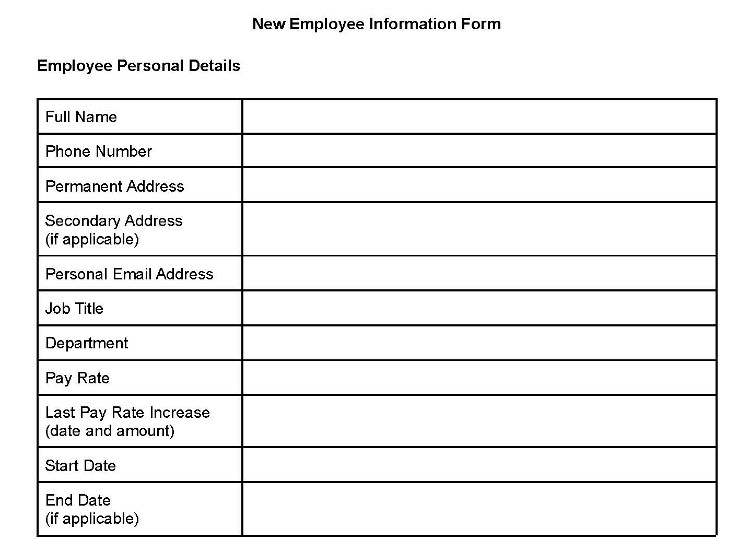
This article is part of a larger series on Hiring.
A new employee information form collects vital new hire data that you need to have on file. Your form should include some basic information, like the new hire’s name, contact information, and emergency contact details, as well as some pertinent employment-related details, like their role, hire date, and pay rate.
Keeping this information helps you ensure you have accurate data on your employees, some of which may be required by state or federal law. Building your new employee information form doesn’t have to be complex—you just need to ensure you have the right data collected.
Here’s a free new employee information form template that you can use and modify to fit your business needs.
FILE TO DOWNLOAD OR INTEGRATE
New Employee Information Form
Download as Word Doc Download as Google Doc Download as PDF
Once the hiring process is done, the next step is to collect some essential information from each of your new hires—and the best way to approach this is through the employee information form.
Your new hire employee information form should be given during a new employee’s onboarding process. Make sure that it is completed and in your HR files during your new hire’s first week.
When an employee leaves your company, their new employer may call you to verify some of this information. Having these details in a single place will make it easy for you to pull up and confirm the data.
While your employee personnel files should contain a copy of the new hire’s resume, it’s good practice to have the employee’s educational background and work history on your new hire form. That way, you won’t have to filter through folders just to get certain information—all you need to check is one information sheet. Here are some things you can include:
Your new employee information form must include emergency contact information for your employee. This is crucial information that you’ll need to have readily accessible in case of an emergency. Even in a remote environment, you’ll want to have emergency contact information on hand in case you cannot reach your employee.
At a minimum, get the emergency contact’s first and last name, their relationship to your employee, and multiple forms of contact, like a personal phone number and a work phone number. It’s a good practice to ask for a backup emergency contact too.
As part of the employment verification process, you’ll need to collect some confidential information about your employees. This includes their Social Security number.
You will need to have this number handy to complete Form I-9 for employment verification or for verifying payroll information. Collecting it early on makes it easy to complete your onboarding process.
Along with the Social Security number, you’ll need to collect some other confidential information from your new hires, such as their bank account information to set up their direct deposit.
Beyond the information covered above, there are forms and other information that you’ll need to collect during a new hire’s first few days. See our new employee forms guide for details. And for more information on what to keep, collect, and file together, check out our full guide to keeping personnel files.
Keeping your employee data safe and secure is crucial, both to ensure compliance and to gain your employees’ trust. Your new employee information forms—all employee personnel files, in fact—should be kept in a locked cabinet in a locked room. In a remote environment or fully digital workplace, it’s acceptable to keep these files digitally. However, make absolutely certain that access to them is restricted to only your HR department.
Additionally, some states require you to keep certain personnel information and payroll records for a period of time, even after separation from an employee. Similarly, the federal government requires keeping I-9 Forms separate from all other employee documents. As a reminder, these protection requirements include both current and former employees.
Pro Tip: Set a regular schedule to update the data in your employee information forms. Employees move and change names, their emergency contacts get new phone numbers, etc.—so you’ll need to build a process to ensure these forms remain accurate.
Collecting employee information isn’t always front of mind for employers—but it needs to be. You’re required to keep some information on each employee, and it’s a good business practice to ensure that data is regularly updated. By using a templated employee information form, you can ensure that you get all your employees’ data from their first day.
Find Charlette On LinkedIn
Charlette Beasley is Associate Director of Content for the Accounting, HR, Retail, Finance, and Insurance topics on FitSmallBusiness.com, where she works to develop and support editorial leaders on their mission to deliver the best answer to our readers in their areas of expertise. She has more than 10 years of publishing experience between magazines and websites. She's written columns about local small businesses, digital content on payroll, HR, and technology, and helped businesses in various industries strategize and successfully execute on creating quality content for their online blogs.